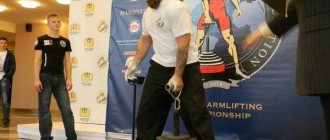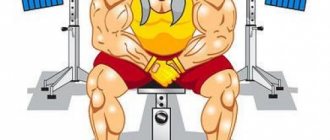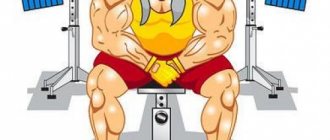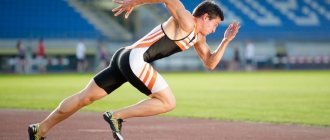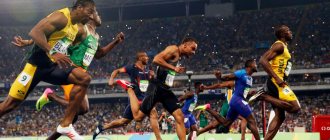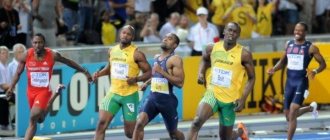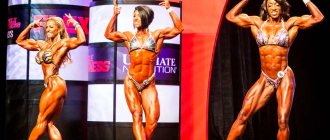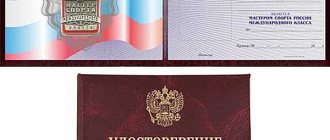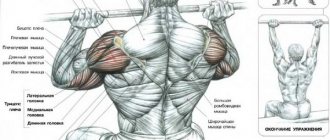Sports training and strength exercises are extremely varied. New exercises are constantly appearing that are aimed at working one or another muscle group. Armlifting is a relatively new sport that is actively gaining popularity.
Armlifting – literally translated from English means “lifting with your hand.” This name fully reflects the essence of the exercise. The athlete must lift a large weight with one hand, without helping himself with any equipment or free hand.
The difficulty of the training is that the entire load during the grip falls only on the hand and forearm, so they must be as developed as possible.
For armlifting competitions, as well as for training, a special projectile is used, which is called Rolling Thunder (literally translated from English - “rolling thunder,” but athletes call it “Rolling Thunder”).
The projectile is a load of varying weights, which has a round rotating handle with a diameter of 60 mm. It is with this handle that the athlete needs to lift the apparatus, demonstrating maximum grip and hand strength.
WRPF and WEPF Bench Press Standards
WRPF (World RAW Powerlifting Federation)
Amateurs undergoing doping control
Without equipment
Men
| Weight category | MSMK | MS | KMS | I | II | III |
| 52 | 110 | 95 | 82.5 | 75 | 67.5 | 57.5 |
| 56 | 120 | 102.5 | 90 | 80 | 72.5 | 62.5 |
| 60 | 127.5 | 112.5 | 97.5 | 87.5 | 77.5 | 67.5 |
| 67.5 | 142.5 | 125 | 107.5 | 97.5 | 87.5 | 75 |
| 75 | 155 | 135 | 117.5 | 105 | 95 | 82.5 |
| 82.5 | 167.5 | 145 | 127.5 | 112.5 | 102.5 | 87.5 |
| 90 | 175 | 152.5 | 132.5 | 120 | 107.5 | 92.5 |
| 100 | 185 | 162.5 | 140 | 125 | 112.5 | 97.5 |
| 110 | 195 | 167.5 | 147.5 | 132.5 | 117.5 | 100 |
| 125 | 202.5 | 177.5 | 152.5 | 137.5 | 122.5 | 105 |
| 140 | 210 | 182.5 | 157.5 | 142.5 | 127.5 | 110 |
| 140+ | 215 | 187.5 | 162.5 | 145 | 130 | 112.5 |
Women
| Weight category | MSMK | MS | KMS | I | II | III |
| 44 | 55 | 47.5 | 40 | 37.5 | 32.5 | 27.5 |
| 48 | 60 | 52.5 | 45 | 40 | 37.5 | 32.5 |
| 52 | 67.5 | 57.5 | 50 | 45 | 40 | 35 |
| 56 | 72.5 | 62.5 | 55 | 47.5 | 42.5 | 37.5 |
| 60 | 77.5 | 67.5 | 57.5 | 52.5 | 47.5 | 40 |
| 67.5 | 85 | 75 | 65 | 57.5 | 52.5 | 45 |
| 75 | 92.5 | 80 | 70 | 62.5 | 57.5 | 47.5 |
| 82.5 | 97.5 | 85 | 75 | 67.5 | 60 | 52.5 |
| 90 | 102.5 | 90 | 77.5 | 70 | 62.5 | 55 |
| 90+ | 107.5 | 92.5 | 80 | 72.5 | 65 | 57.5 |
Amateurs without doping control
Without equipment
Men
| Weight category | MSMK | MS | KMS | I | II | III |
| 52 | 125 | 107.5 | 92.5 | 82.5 | 72.5 | 65 |
| 56 | 135 | 117.5 | 100 | 90 | 80 | 70 |
| 60 | 145 | 125 | 110 | 97.5 | 87.5 | 75 |
| 67.5 | 162.5 | 142.5 | 122.5 | 110 | 97.5 | 85 |
| 75 | 177.5 | 155 | 135 | 120 | 107.5 | 95 |
| 82.5 | 192.5 | 165 | 142.5 | 127.5 | 115 | 100 |
| 90 | 202.5 | 175 | 152.5 | 135 | 120 | 107.5 |
| 100 | 215 | 185 | 160 | 142.5 | 127.5 | 115 |
| 110 | 222.5 | 192.5 | 167.5 | 150 | 135 | 120 |
| 125 | 235 | 202.5 | 175 | 157.5 | 140 | 125 |
| 140 | 242.5 | 210 | 182.5 | 162.5 | 145 | 130 |
| 140+ | 247.5 | 215 | 187.5 | 167.5 | 150 | 135 |
Women
| Weight category | MSMK | MS | KMS | I | II | III |
| 44 | 65 | 55 | 47.5 | 42.5 | 37.5 | 32.5 |
| 48 | 70 | 62.5 | 55 | 47.5 | 42.5 | 37.5 |
| 52 | 77.5 | 67.5 | 60 | 52.5 | 47.5 | 42.5 |
| 56 | 85 | 72.5 | 65 | 57.5 | 52.5 | 47.5 |
| 60 | 90 | 77.5 | 67.5 | 62.5 | 55 | 50 |
| 67.5 | 100 | 87.5 | 75 | 67.5 | 60 | 55 |
| 75 | 110 | 95 | 82.5 | 75 | 67.5 | 57.5 |
| 82.5 | 115 | 100 | 87.5 | 77.5 | 70 | 60 |
| 90 | 122.5 | 105 | 92.5 | 82.5 | 75 | 62.5 |
| 90+ | 125 | 110 | 95 | 85 | 77.5 | 65 |
Amateurs undergoing doping control
In single layer clothing
Men
| Weight category | MSMK | MS | KMS | I | II | III |
| 52 | 120 | 105 | 92.5 | 85 | 75 | 65 |
| 56 | 132.5 | 115 | 102.5 | 92.5 | 82.5 | 72.5 |
| 60 | 142.5 | 125 | 110 | 100 | 90 | 77.5 |
| 67.5 | 157.5 | 137.5 | 120 | 110 | 97.5 | 85 |
| 75 | 180 | 157.5 | 140 | 125 | 115 | 100 |
| 82.5 | 197.5 | 172.5 | 150 | 137.5 | 122.5 | 107.5 |
| 90 | 210 | 185 | 160 | 145 | 132.5 | 115 |
| 100 | 225 | 197.5 | 172.5 | 150 | 137.5 | 122.5 |
| 110 | 242.5 | 212.5 | 187.5 | 170 | 152.5 | 132.5 |
| 125 | 257.5 | 225 | 197.5 | 180 | 162.5 | 140 |
| 140 | 267.5 | 235 | 207.5 | 187.5 | 170 | 147.5 |
| 140+ | 277.5 | 242.5 | 212.5 | 192.5 | 175 | 152.5 |
Women
| Weight category | MSMK | MS | KMS | I | II | III |
| 44 | 62.5 | 55 | 47.5 | 42.5 | 37.5 | 32.5 |
| 48 | 67.5 | 60 | 52.5 | 47.5 | 42.5 | 37.5 |
| 52 | 75 | 65 | 57.5 | 52.5 | 47.5 | 40 |
| 56 | 85 | 72.5 | 65 | 57.5 | 52.5 | 45 |
| 60 | 90 | 80 | 70 | 62.5 | 57.5 | 52.5 |
| 67.5 | 100 | 87.5 | 77.5 | 70 | 62.5 | 55 |
| 75 | 107.5 | 95 | 82.5 | 75 | 67.5 | 60 |
| 82.5 | 120 | 107.5 | 95 | 85 | 77.5 | 67.5 |
| 90 | 127.5 | 112.5 | 97.5 | 90 | 80 | 70 |
| 90+ | 130 | 115 | 100 | 92.5 | 82.5 | 72.5 |
In multi-layered clothing
Men
| Weight category | MSMK | MS | KMS | I | II | III |
| 52 | 125 | 110 | 97.5 | 87.5 | 77.5 | 67.5 |
| 56 | 137.5 | 120 | 105 | 95 | 85 | 75 |
| 60 | 150 | 130 | 115 | 102.5 | 92.5 | 80 |
| 67.5 | 170 | 147.5 | 130 | 117.5 | 105 | 90 |
| 75 | 192.5 | 170 | 147.5 | 135 | 122.5 | 105 |
| 82.5 | 210 | 182.5 | 160 | 145 | 132.5 | 115 |
| 90 | 225 | 195 | 172.5 | 155 | 140 | 122.5 |
| 100 | 240 | 210 | 185 | 165 | 150 | 130 |
| 110 | 257.5 | 227.5 | 200 | 180 | 162.5 | 142.5 |
| 125 | 275 | 240 | 210 | 190 | 172.5 | 150 |
| 140 | 285 | 250 | 220 | 200 | 180 | 157.5 |
| 140+ | 295 | 260 | 227.5 | 205 | 185 | 162.5 |
Women
| Weight category | MSMK | MS | KMS | I | II | III |
| 44 | 67.5 | 60 | 52.5 | 47.5 | 42.5 | 37.5 |
| 48 | 75 | 65 | 57.5 | 52.5 | 47.5 | 40 |
| 52 | 82.5 | 72.5 | 62.5 | 57.5 | 50 | 45 |
| 56 | 92.5 | 80 | 70 | 62.5 | 57.5 | 50 |
| 60 | 97.5 | 85 | 75 | 67.5 | 62.5 | 52.5 |
| 67.5 | 110 | 95 | 82.5 | 75 | 67.5 | 60 |
| 75 | 117.5 | 102.5 | 90 | 82.5 | 75 | 65 |
| 82.5 | 132.5 | 115 | 102.5 | 92.5 | 85 | 72.5 |
| 90 | 137.5 | 122.5 | 107.5 | 97.5 | 87.5 | 77.5 |
| 90+ | 142.5 | 125 | 110 | 100 | 90 | 80 |
Amateurs without doping control
In single layer clothing
Men
| Weight category | MSMK | MS | KMS | I | II | III |
| 52 | 142.5 | 125 | 107.5 | 97.5 | 87.5 | 77.5 |
| 56 | 155 | 135 | 117.5 | 107.5 | 95 | 82.5 |
| 60 | 167.5 | 147.5 | 127.5 | 115 | 105 | 90 |
| 67.5 | 185 | 162.5 | 142.5 | 127.5 | 115 | 100 |
| 75 | 210 | 185 | 162.5 | 147.5 | 132.5 | 115 |
| 82.5 | 230 | 200 | 175 | 157.5 | 142.5 | 125 |
| 90 | 245 | 215 | 187.5 | 170 | 152.5 | 132.5 |
| 100 | 262.5 | 230 | 202.5 | 182.5 | 165 | 142.5 |
| 110 | 282.5 | 247.5 | 217.5 | 197.5 | 177.5 | 155 |
| 125 | 300 | 262.5 | 230 | 207.5 | 187.5 | 162.5 |
| 140 | 312.5 | 275 | 240 | 217.5 | 195 | 170 |
| 140+ | 322.5 | 282.5 | 247.5 | 225 | 202.5 | 175 |
Women
| Weight category | MSMK | MS | KMS | I | II | III |
| 44 | 72.5 | 62.5 | 55 | 50 | 45 | 40 |
| 48 | 80 | 70 | 62.5 | 55 | 50 | 42.5 |
| 52 | 87.5 | 77.5 | 67.5 | 60 | 55 | 47.5 |
| 56 | 97.5 | 85 | 75 | 67.5 | 62.5 | 55 |
| 60 | 105 | 92.5 | 80 | 72.5 | 65 | 57.5 |
| 67.5 | 117.5 | 102.5 | 90 | 80 | 72.5 | 62.5 |
| 75 | 127.5 | 110 | 97.5 | 87.5 | 80 | 67.5 |
| 82.5 | 140 | 122.5 | 107.5 | 97.5 | 90 | 77.5 |
| 90 | 147.5 | 130 | 115 | 102.5 | 92.5 | 82.5 |
| 90+ | 155 | 137.5 | 122.5 | 110 | 100 | 90 |
In multi-layered clothing
Men
| Weight category | MSMK | MS | KMS | I | II | III |
| 52 | 147.5 | 130 | 112.5 | 102.5 | 92.5 | 82.5 |
| 56 | 160 | 140 | 122.5 | 112.5 | 100 | 87.5 |
| 60 | 175 | 152.5 | 132.5 | 120 | 110 | 95 |
| 67.5 | 197.5 | 172.5 | 152.5 | 137.5 | 122.5 | 105 |
| 75 | 225 | 197.5 | 172.5 | 155 | 140 | 122.5 |
| 82.5 | 245 | 215 | 187.5 | 170 | 152.5 | 132.5 |
| 90 | 262.5 | 230 | 200 | 180 | 162.5 | 142.5 |
| 100 | 280 | 245 | 215 | 195 | 175 | 152.5 |
| 110 | 302.5 | 265 | 232.5 | 210 | 190 | 165 |
| 125 | 320 | 280 | 245 | 222.5 | 200 | 175 |
| 140 | 335 | 292.5 | 257.5 | 232.5 | 210 | 182.5 |
| 140+ | 345 | 302.5 | 265 | 237.5 | 215 | 187.5 |
Women
| Weight category | MSMK | MS | KMS | I | II | III |
| 44 | 80 | 70 | 60 | 55 | 50 | 42.5 |
| 48 | 87.5 | 77.5 | 67.5 | 60 | 55 | 47.5 |
| 52 | 97.5 | 85 | 72.5 | 65 | 60 | 52.5 |
| 56 | 107.5 | 92.5 | 82.5 | 75 | 67.5 | 57.5 |
| 60 | 115 | 100 | 87.5 | 80 | 72.5 | 62.5 |
| 67.5 | 127.5 | 112.5 | 97.5 | 87.5 | 80 | 70 |
| 75 | 137.5 | 120 | 105 | 95 | 87.5 | 75 |
| 82.5 | 152.5 | 135 | 117.5 | 107.5 | 97.5 | 85 |
| 90 | 160 | 140 | 125 | 112.5 | 102.5 | 90 |
| 90+ | 165 | 145 | 127.5 | 115 | 105 | 95 |
Armlifting records[edit | edit code]
Grip strength training
World Records for Armlifting[edit | edit code]
Records according to the World Armlifting Association
Sergey Badyuk at an armlifting tournament
- Men
+110 k - Alexey Tyukalov - 148 kg (own weight 123 kg) Russia-Finland (note: Absolute record) - 110 k — Kulyasov Sergey — 120.5 kg (own weight 98.4 kg) Russia
- 90 k – Bashun Victor (Viktor Blud) – 115.5 kg (own weight 84 kg) Russia
- 70 k - Alexey Laptev - 100.5 kg (own weight 68.4 kg) Russia
- Juniors
+90 k – Grigory Kopaigora – 103 kg (own weight 99.4 kg) Ukraine - 90 k — Omelyanenko Oleg -97.5 kg (own weight 84.5 kg) Ukraine
- 70 k - Alexey Laptev - 100.5 kg (own weight 68.4 kg) Russia
- Women
+60 k — Lyudmila Gaiduchenko – 68 kg (own weight 91.2 kg) Ukraine 60 k — Yulia Dvorskaya — 50.5 kg (own weight 55.9 kg) Ukraine
- Veterans (+40)
+90 k Melentyev Oleg – 135.5 kg (own weight 142 kg) Russia - 90 k Khasai Khvich – 98.5 kg (own weight 89.9 kg) Ukraine
Benefits and harms
What is powerlifting, what standards, titles and categories exist?
Benefits of powerlifting:
- All muscle groups are strengthened and an athletic figure is formed.
- Strength indicators improve.
- Develops flexibility and coordination.
- Posture is corrected.
- You can lose weight or increase muscle mass - it all depends on nutrition.
- A good base for practicing any sport is being built.
Possible harm is also present:
- Quite a high risk of injury.
- The training is hard and long.
- Causes dependence on working weights and competitive results. This leads to irrational use of sports pharmacology and psychological problems, especially among beginners.
Alen Ajan - stock.adobe.com
Federations:
People's bench press standards awpc: official category standards (requirements) for people's press (awpc)
And thirdly, the federations for which we will consider the bench press standards (it should be noted that there are too many of them, so we will consider the standards from several of the most popular at the moment):
IPF – International Powerlifting Federation (IPF) is the oldest and most authoritative international federation, founded in 1973.
WPC – World Powerlifting Congress (WPC) is the oldest and most authoritative of the international alternative federations. Founded in 1986 by Ernie Frantz
- no doping control
- Monolift use is allowed
- multi-layered equipment, including those made of tarpaulin and denim; open back bench shirts; overalls with Velcro; knee bandages up to 2.5 m; Briefs are allowed (reinforcing shorts made of rigid fabric, worn under overalls)
- the bare-knuckle division appeared much earlier
- specialized exercise bars
AWPC – Amateur World Powerlifting Congress, WPC division for competitions with doping control, created in 1999.
Bench Rating Standards 2014 WPC – Single Layer Equipment
Men
| Weight category | Elite | MSMK | MS | KMS | I | II | III | I junior | II junior |
| 52 | 157.5 | 137.5 | 120 | 102.5 | 92.5 | 82.5 | 72.5 | 60 | 47.5 |
| 56 | 172.5 | 150 | 130 | 112.5 | 102.5 | 90 | 77.5 | 65 | 52.5 |
| 60 | 187.5 | 162.5 | 142.5 | 122.5 | 110 | 100 | 85 | 70 | 57.5 |
| 67.5 | 210 | 180 | 157.5 | 137.5 | 122.5 | 110 | 95 | 77.5 | 62.5 |
| 75 | 232.5 | 200 | 175 | 152.5 | 137.5 | 122.5 | 105 | 87.5 | 70 |
| 82.5 | 252.5 | 220 | 190 | 165 | 147.5 | 132.5 | 115 | 95 | 77.5 |
| 90 | 272.5 | 235 | 205 | 177.5 | 160 | 142.5 | 122.5 | 102.5 | 82.5 |
| 100 | 292.5 | 252.5 | 220 | 192.5 | 172.5 | 155 | 132.5 | 110 | 87.5 |
| 110 | 310 | 267.5 | 232.5 | 202.5 | 182.5 | 162.5 | 140 | 117.5 | 92.5 |
| 125 | 330 | 285 | 247.5 | 215 | 192.5 | 172.5 | 147.5 | 125 | 100 |
| 140 | 345 | 297.5 | 260 | 225 | 202.5 | 180 | 155 | 130 | 102.5 |
| 140+ | 355 | 307.5 | 267.5 | 232.5 | 210 | 187.5 | 160 | 135 | 107.5 |
Women
| Weight category | Elite | MSMK | MS | KMS | I | II | III | I junior | II junior |
| 44 | 80 | 70 | 60 | 52.5 | 47.5 | 42.5 | 37.5 | 30 | 25 |
| 48 | 90 | 77.5 | 67.5 | 60 | 52.5 | 47.5 | 40 | 35 | 27.5 |
| 52 | 100 | 85 | 75 | 65 | 57.5 | 52.5 | 45 | 37.5 | 30 |
| 56 | 107.5 | 92.5 | 80 | 70 | 62.5 | 57.5 | 47.5 | 40 | 32.5 |
| 60 | 115 | 100 | 87.5 | 75 | 67.5 | 60 | 52.5 | 42.5 | 35 |
| 67.5 | 130 | 112.5 | 97.5 | 85 | 75 | 67.5 | 57.5 | 47.5 | 40 |
| 75 | 140 | 122.5 | 105 | 92.5 | 82.5 | 75 | 62.5 | 52.5 | 42.5 |
| 82.5 | 150 | 130 | 112.5 | 97.5 | 87.5 | 80 | 67.5 | 57.5 | 45 |
| 90 | 160 | 137.5 | 120 | 105 | 92.5 | 82.5 | 72.5 | 60 | 47.5 |
| 90+ | 162.5 | 142.5 | 122.5 | 107.5 | 95 | 85 | 75 | 62.5 | 50 |
WPC bench press category standards - multi-layer equipment (2014)
Men
| Weight category | Elite | MSMK | MS | KMS | I | II | III | I junior | II junior |
| 52 | 165 | 142.5 | 125 | 107.5 | 97.5 | 87.5 | 75 | 62.5 | 50 |
| 56 | 180 | 155 | 135 | 117.5 | 105 | 95 | 82.5 | 67.5 | 55 |
| 60 | 195 | 170 | 147.5 | 127.5 | 115 | 102.5 | 87.5 | 72.5 | 60 |
| 67.5 | 225 | 192.5 | 167.5 | 147.5 | 132.5 | 117.5 | 100 | 85 | 67.5 |
| 75 | 250 | 215 | 187.5 | 162.5 | 145 | 130 | 112.5 | 92.5 | 75 |
| 82.5 | 272.5 | 235 | 205 | 177.5 | 160 | 142.5 | 122.5 | 102.5 | 82.5 |
| 90 | 292.5 | 252.5 | 220 | 190 | 170 | 152.5 | 132.5 | 110 | 87.5 |
| 100 | 312.5 | 270 | 235 | 205 | 185 | 165 | 142.5 | 117.5 | 95 |
| 110 | 332.5 | 287.5 | 250 | 217.5 | 195 | 175 | 150 | 125 | 100 |
| 125 | 352.5 | 305 | 265 | 230 | 207.5 | 185 | 160 | 132.5 | 105 |
| 140 | 370 | 320 | 277.5 | 242.5 | 217.5 | 195 | 167.5 | 137.5 | 110 |
| 140+ | 382.5 | 330 | 287.5 | 250 | 222.5 | 200 | 172.5 | 142.5 | 115 |
Women
| Weight category | Elite | MSMK | MS | KMS | I | II | III | I junior | II junior |
| 44 | 87.5 | 77.5 | 67.5 | 57.5 | 52.5 | 47.5 | 40 | 32.5 | 27.5 |
| 48 | 97.5 | 85 | 75 | 65 | 57.5 | 52.5 | 45 | 37.5 | 30 |
| 52 | 107.5 | 95 | 82.5 | 70 | 62.5 | 57.5 | 50 | 40 | 32.5 |
| 56 | 117.5 | 102.5 | 87.5 | 77.5 | 70 | 62.5 | 52.5 | 45 | 35 |
| 60 | 127.5 | 110 | 95 | 82.5 | 75 | 67.5 | 57.5 | 47.5 | 37.5 |
| 67.5 | 142.5 | 122.5 | 107.5 | 92.5 | 82.5 | 75 | 65 | 52.5 | 42.5 |
| 75 | 155 | 132.5 | 115 | 100 | 90 | 82.5 | 70 | 57.5 | 47.5 |
| 82.5 | 165 | 142.5 | 125 | 107.5 | 97.5 | 87.5 | 75 | 62.5 | 50 |
| 90 | 175 | 150 | 130 | 115 | 102.5 | 92.5 | 77.5 | 65 | 52.5 |
| 90+ | 180 | 155 | 135 | 117.5 | 105 | 95 | 80 | 67.5 | 55 |
WPC category standards bench press - without equipment (2014)
Men
| Weight category | Elite | MSMK | MS | KMS | I | II | III | I junior | II junior |
| 52 | 150 | 130 | 112.5 | 97.5 | 87.5 | 77.5 | 67.5 | 55 | 45 |
| 56 | 162.5 | 140 | 122.5 | 105 | 95 | 85 | 72.5 | 60 | 47.5 |
| 60 | 175 | 150 | 130 | 115 | 102.5 | 92.5 | 77.5 | 65 | 52.5 |
| 67.5 | 195 | 167.5 | 147.5 | 127.5 | 115 | 102.5 | 87.5 | 72.5 | 57.5 |
| 75 | 212.5 | 182.5 | 160 | 140 | 125 | 112.5 | 95 | 80 | 65 |
| 82.5 | 227.5 | 197.5 | 170 | 147.5 | 132.5 | 120 | 102.5 | 85 | 67.5 |
| 90 | 240 | 207.5 | 180 | 157.5 | 140 | 125 | 107.5 | 90 | 72.5 |
| 100 | 252.5 | 220 | 190 | 165 | 147.5 | 132.5 | 115 | 95 | 75 |
| 110 | 265 | 227.5 | 197.5 | 172.5 | 155 | 140 | 120 | 100 | 80 |
| 125 | 275 | 240 | 207.5 | 180 | 162.5 | 145 | 125 | 105 | 82.5 |
| 140 | 285 | 247.5 | 215 | 187.5 | 167.5 | 150 | 130 | 107.5 | 85 |
| 140+ | 292.5 | 252.5 | 220 | 192.5 | 172.5 | 155 | 132.5 | 110 | 87.5 |
Women
| Weight category | Elite | MSMK | MS | KMS | I | II | III | I junior | II junior |
| 44 | 75 | 65 | 55 | 47.5 | 42.5 | 40 | 35 | 27.5 | 22.5 |
| 48 | 82.5 | 70 | 62.5 | 55 | 47.5 | 42.5 | 37.5 | 30 | 25 |
| 52 | 90 | 77.5 | 67.5 | 60 | 52.5 | 47.5 | 40 | 35 | 27.5 |
| 56 | 97.5 | 85 | 72.5 | 65 | 57.5 | 52.5 | 45 | 37.5 | 30 |
| 60 | 105 | 90 | 77.5 | 67.5 | 62.5 | 55 | 47.5 | 40 | 32.5 |
| 67.5 | 117.5 | 100 | 87.5 | 75 | 67.5 | 60 | 52.5 | 42.5 | 35 |
| 75 | 125 | 110 | 95 | 82.5 | 75 | 67.5 | 57.5 | 47.5 | 37.5 |
| 82.5 | 135 | 115 | 100 | 87.5 | 77.5 | 70 | 60 | 50 | 40 |
| 90 | 140 | 122.5 | 105 | 92.5 | 82.5 | 75 | 62.5 | 52.5 | 42.5 |
| 90+ | 145 | 125 | 110 | 95 | 85 | 75 | 65 | 55 | 45 |
STANDARDS FOR WOMEN | without doping control
Deadlift: standards
(powerlifting without equipment)
| Weight category | Federation | MSMK | MS | KMS | I rank | II category | III category |
| 44 kg | WPC | 300 | 260 | 235 | 210 | 182.5 | 157.5 |
| WRPF | 297.5 | 255 | 220 | 197.5 | 177.5 | 147.5 | |
| SPR | 295 | 252.5 | 217.5 | 195 | 175 | 145 | |
| NAP | 310 | 265 | 230 | 200 | 172.5 | 142.5 | |
| 48 kg | WPC | 330 | 287.5 | 260 | 230 | 202.5 | 172.5 |
| WRPF | 325 | 280 | 245 | 215 | 190 | 162.5 | |
| SPR | 322.5 | 277.5 | 242.5 | 212.5 | 187.5 | 160 | |
| NAP | 340 | 292.5 | 255 | 222.5 | 195 | 165 | |
| 52 kg | WPC | 360 | 312.5 | 282.5 | 250 | 220 | 187.5 |
| WRPF | 352.5 | 305 | 265 | 232.5 | 210 | 177.5 | |
| SPR | 350 | 302.5 | 262.5 | 230 | 207.5 | 175 | |
| NAP | 367.5 | 317.5 | 277.5 | 242.5 | 212.5 | 180 | |
| 56 kg | WPC | 387.5 | 335 | 302.5 | 270 | 235 | 202.5 |
| WRPF | 380 | 325 | 285 | 250 | 225 | 192.5 | |
| SPR | 375 | 320 | 280 | 245 | 220 | 187.5 | |
| NAP | 390 | 337.5 | 295 | 260 | 227.5 | 195 | |
| 60 kg | WPC | 410 | 357.5 | 322.5 | 285 | 250 | 215 |
| WRPF | 400 | 345 | 312.5 | 270 | 237.5 | 205 | |
| SPR | 395 | 340 | 307.5 | 265 | 232.5 | 200 | |
| NAP | 425 | 370 | 322.5 | 285 | 250 | 215 | |
| 67.5 kg | WPC | 450 | 390 | 352.5 | 312.5 | 275 | 235 |
| WRPF | 427.5 | 372.5 | 325 | 287.5 | 257.5 | 220 | |
| SPR | 422.5 | 367.5 | 320 | 282.5 | 252.5 | 215 | |
| NAP | 452.5 | 395 | 345 | 305 | 267.5 | 230 | |
| 75 kg | WPC | 482.5 | 420 | 377.5 | 335 | 292.5 | 252.5 |
| WRPF | 457.5 | 395 | 340 | 305 | 275 | 230 | |
| SPR | 452.5 | 390 | 335 | 300 | 270 | 225 | |
| NAP | 482.5 | 420 | 377.5 | 317.5 | 280 | 240 | |
| 82.5 kg | WPC | 507.5 | 442.5 | 397.5 | 352.5 | 310 | 265 |
| WRPF | 480 | 417.5 | 365 | 322.5 | 290 | 247.5 | |
| SPR | 470 | 407.5 | 355 | 312.5 | 280 | 237.5 | |
| NAP | 507.5 | 442.5 | 397.5 | 352.5 | 310 | 265 | |
| 90 kg | WPC | 527.5 | 460 | 415 | 367.5 | 322.5 | 275 |
| WRPF | 502.5 | 430 | 380 | 335 | 300 | 255 | |
| SPR | 492.5 | 420 | 370 | 325 | 290 | 245 | |
| NAP | 530 | 460 | 415 | 367.5 | 322.5 | 277.5 | |
| 90+ kg | WPC | 540 | 470 | 422.5 | 375 | 330 | 282.5 |
| WRPF | 510 | 442.5 | 387.5 | 342.5 | 307.5 | 262.5 | |
| SPR | 500 | 432.5 | 377.5 | 332.5 | 297.5 | 252.5 | |
| NAP | 540 | 470 | 422.5 | 375 | 330 | 282.5 |
CONVENTIONAL ABBREVIATIONS: MSMC MS KMS I II III WPC AWPC WRPF SPR NAP
Discussion on the forum (comments: )
Article added: 2020-12-25
| Standards for powerlifting, table of ranks (IPF/FPR) Official standards of IPF in powerlifting, table of ranks and norms (2018-2021) Standards for the bench press (without equipment) Table of rank standards for the bench press, without equipment (federation : WPC, AWPC, WRPF, SPR, NAP) Standards for squats with a barbell (without equipment) Table of rank standards for squats with a barbell, without equipment (federations NAP and SPR) Standards for deadlift (without equipment) Table of rank standards for deadlifts without equipment (federations: WPC, AWPC, WRPF, SPR, NAP) Standards for streetlifting Table of standards and categories for streetlifting (pull-ups and push-ups on uneven bars with weights) |
DIFFERENT STANDARDS FOR WOMEN | without doping control
(STRICT BICEPS RAISE)
| Weight category | Federation | MSMK | MS | KMS | I rank | II category | III category |
| 44 kg | WPC | 32.5 | 30 | 25 | 22.5 | 20 | 17.5 |
| WRPF | 37.5 | 30 | 25 | 22.5 | 20 | 17.5 | |
| NAP | 32.5 | 30 | 25 | — | — | — | |
| 48 kg | WPC | 35 | 32.5 | 27.5 | 25 | 22.5 | 20 |
| WRPF | 40 | 32.5 | 27.5 | 25 | 22.5 | 20 | |
| NAP | 35 | 32.5 | 27.5 | 20 | — | — | |
| 52 kg | WPC | 37.5 | 35 | 30 | 27.5 | 25 | 22.5 |
| WRPF | 42.5 | 35 | 30 | 27.5 | 25 | 22.5 | |
| SPR | 40 | 37.5 | 32.5 | 27.5 | 22.5 | 20 | |
| NAP | 37.5 | 35 | 30 | 22.5 | 20 | — | |
| 56 kg | WPC | 40 | 37.5 | 32.5 | 30 | 27.5 | 25 |
| WRPF | 45 | 37.5 | 32.5 | 30 | 27.5 | 25 | |
| 60 kg | WPC | 42.5 | 40 | 35 | 32.5 | 30 | 27.5 |
| WRPF | 47.5 | 40 | 35 | 32.5 | 30 | 27.5 | |
| SPR | 42.5 | 40 | 35 | 30 | 25 | 22.5 | |
| NAP | 40 | 37.5 | 32.5 | 27.5 | 22.5 | 20 | |
| 67.5 kg | WPC | 45 | 42.5 | 37.5 | 35 | 32.5 | 30 |
| WRPF | 50 | 42.5 | 37.5 | 35 | 32.5 | 30 | |
| SPR | 47.5 | 42.5 | 37.5 | 35 | 30 | 25 | |
| NAP | 45 | 40 | 35 | 30 | 27.5 | 22.5 | |
| 75 kg | WPC | 50 | 45 | 40 | 37.5 | 35 | 32.5 |
| WRPF | 52.5 | 45 | 40 | 37.5 | 35 | 32.5 | |
| SPR | 50 | 47.5 | 42.5 | 37.5 | 35 | 32.5 | |
| NAP | 47.5 | 45 | 37.5 | 35 | 32.5 | 30 | |
| 75+ kg | SPR | 60 | 50 | 45 | 42.5 | 37.5 | 35 |
| NAP | 55 | 47.5 | 42.5 | 37.5 | 35 | 32.5 | |
| 82.5 kg | WPC | 52.5 | 47.5 | 42.5 | 40 | 37.5 | 35 |
| WRPF | 55 | 47.5 | 42.5 | 40 | 37.5 | 32.5 | |
| 90 kg | WPC | 55 | 50 | 45 | 42.5 | 40 | 37.5 |
| WRPF | 57.5 | 50 | 45 | 42.5 | 40 | 37.5 | |
| 90+ kg | WPC | 57.5 | 52.5 | 47.5 | 45 | 42.5 | 40 |
| WRPF | 60 | 52.5 | 47.5 | 45 | 42.5 | 40 |
CONVENTIONAL ABBREVIATIONS: MSMC MS KMS I II III WPC AWPC WRPF SPR NAP Rules for performing the exercise “Strict barbell curl”:
| 1. | The athlete stands facing the front of the platform. The bar should be held horizontally at hip level. Palms facing up, fingers should clasp the bar. The legs should be level on the platform, the knees and arms should be fully straightened. One foot can be in front of the other (staggered feet) as long as the knees are straight and the feet are level on the platform. |
| 2. | The athlete in the starting position awaits the command of the chief judge. The command is given as soon as the athlete demonstrates readiness and the bar is properly positioned. The signal is an upward movement of the hand along with the distinct command “Curl.” |
| 3. | As soon as the command is given, the athlete must lift the barbell, arms fully bent at the elbows (barbell at chin or throat level, palms facing back). Your knees should remain straight and your shoulders aligned (at right angles) or back throughout the exercise. |
| 4. | When completing the lifting phase, the knees should remain straight and the shoulders should be straightened or pulled back. |
| 5. | The legs and hips should not be used in any way to generate the push to complete the exercise. The athlete should not lean back to assist in lifting the weight. Any pushing with legs or hips is prohibited. |
| 6. | When the final position is reached, the head referee gives the signal by moving his hand downwards along with the clear command “Down”. The signal is not given until the bar is secured and the athlete has reached the final position. |
| 7. | Any upward movement of the barbell or any deliberate attempt to lift the barbell is considered a used attempt. |
| 8. | The athlete is given an additional attempt with the same weight of the barbell if the mistake was made due to the fault of the assistants setting the weight. |
| 9. | Any upward movement of the barbell or any deliberate attempt to lift the barbell is considered a used attempt. |
Reasons why weight does not count in a strict biceps curl:
| 1. | Any downward movement of the barbell until it has reached its final position. |
| 2. | The mistake is taking a vertical position with the shoulders turned or laid back. |
| 3. | Error: knees are not straightened during the exercise. |
| 4. | Step back, forward, or swing your foot from heel to toe. |
| 5. | Bouncing the barbell off your hips to begin lifting the barbell. |
| 6. | Failure to comply with the central referee's signals regarding the start and end of the exercise. |
| 7. | Using your legs and hips to create momentum to complete the exercise. |
Discussion on the forum (comments: )
Article added: 2021-01-03
| Standards for the bench press (without equipment) Table of rank standards for the bench press, without equipment (federations: WPC, AWPC, WRPF, SPR, NAP) Standards for powersports Table of standards for powersports (two-event - standing barbell press and biceps curl) Standards for folk bench press Table of rank standards in folk bench press (federations AWPC, WPC, WRPF, SPR, NAP) Standards for powerlifting (without equipment) Table of rank standards for powerlifting (eventing) without equipment. Federations AWPC, WPC, WRPF, SPR, NAP Standards for streetlifting Table of standards and categories for streetlifting (pull-ups and push-ups on uneven bars with weights) |
Content
- 1 Armlifting 1.1 History
- 1.2 Rules
- 1.3 World Armlifting Association
- 1.4 World Armlifting Federation (WAF) / Union of Armlifters of Russia (SAR)
- 2.1 World Records in Armlifting
- 3.1 Armlifting Professional League standards
[5]
[6]
Armlifting
Armlifting
(from the English arm-lifting - hand lifting) - a strength sport, a competition for grip strength, namely, it is necessary to lift and fix the maximum weight using an inconvenient rotating handle - Rolling Thunder. This exercise is difficult because when lifting the weight, the entire load falls on the hand and forearm.
Story
The history of this sport is not new at all, as is commonly believed. The first impetus for its popularization was the performance of the German strongman Hermann Gorner, nicknamed the Mighty, in 1920, who lifted a record weight of 330.0 kg with one hand. Later, even competitions were held to lift the barbell with one hand. Subsequently, many other high results were recorded, which significantly exceed modern ones.
Rules
According to the rules of arm lifting (WAA), the weight must be lifted using a round rotating handle with a diameter of 60 mm - a machine developed in 1993 and officially registered by it under the trademark "Rolling Thunder" (English: Rolling Thunder - rolling thunder; literally translated - "rolling thunder"). thunder"). The exercise is derived from the one-arm deadlift, which occupies a prominent place in the history of strength sports; but armlifting is more complicated, it combines a basic pulling exercise with an awkwardly shaped handle that is very difficult to hold in the palm of your hand. The design of the handle is such that when lifting the weight, the entire load falls on the hand and forearm (it was originally intended as a simulator for the corresponding muscle groups).
Rolling Thunder has established itself as the world standard for grip strength, including as one of the three elements of the GNC Grip Gauntlet competition. As with the Captains of Crush resistance band, results obtained using the Rolling Thunder exercise machine count towards IronMind's ranking list and are the primary measure of the grip strength of the world's strongest people.
Armlifting competitions are interesting due to their unpredictable nature: their result is difficult to guess from the appearance of the participants, since it does not depend on general physical development, but specifically on the grip strength of the hand. Armlifting competitions are often held as entertainment at public events or as additional ones in tournaments in other strength disciplines (powerlifting, strongman, etc.).
World Armlifting Association
File:Armlifting WAA.png Official WAA logo
In 2010, a new stage in the development of armlifting began, the “World Armlifting Association” was created, and, thanks to the leading positions of Russian athletes and their recognized authority in the world, Alexander Anatolyevich Filimonov, president of “ Russian Armwrestling Association". Since the creation of the Armlifting Association, dozens of tournaments at various levels have been successfully held. Arm wrestlers, powerlifters, strongmen, weightlifters, and wrestlers take part in these grip strength competitions with pleasure. In the same 2010, in the city of Podolsk (Moscow region), as part of the Moscow region team arm wrestling championship, the first official grip strength competitions in Russia were held. The record belongs to Alexey Tyukalov, who lifted 150.5 kg
President of the World Armlifting Association
Filimonov A.A.
General Secretary
Vitkevich N.N.
Competitions usually certify results in the following disciplines:
- RT - Clubs: 83, 93, 103, 113 - elite
- AA - Clubs 120, 140, 160, elite - from 180 kg
- KoK - men from 2, women from 1, other expanders are possible
- SB is simply an achieved result. For variety, you can try expanders smaller than No. 3
- Hub - results
- WAA World Records.
History of origin
Some athletes mistakenly believe that the history of armlifting began in 1920. According to this version, the founder of this sport is Hermann Gorner, nicknamed “The Mighty”. During his speech, he demonstrated a block weighing 330 kg, to which a handle was attached.
After Moguchy was able to lift this weight with one hand, his achievement began to be considered a world record. Subsequently, many athletes were able to break his record.
In fact, the history of armlifting began in 1993, when the IronMind training equipment company released the Rolling Thunder simulator.
Initially, the machine was used for training aimed at developing strength, and then grew into a separate sport. Perhaps the popularity of armlifting is justified by the fact that it is never possible to guess the outcome of the competition. The strength indicator in this case does not depend on the appearance of the athlete and on the degree of muscle development.
Records in the field of armlifting
World records in this discipline, according to the World Armlifting Association, are distributed as follows. Among men, first place with a body weight of 123 kg was taken by Alexey Tyukalov from Russia. He lifted a load weighing 148 kg. And this is an absolute record in this type of competition. The further distribution of places among men looks like this
- Sergey Kulyasov - 120.5 kg with a body weight of 98 kg;
- Victor Blud - 115.5 kg with a body weight of 84 kg;
- Alexey Laptev - 100.5 kg and with his own body weight of 68 kg.
Juniors also competed:
- Kopaigora Grigory - weight 103 kg (with his own 99.4 kg) country - Ukraine;
- Omelyanenko Oleg – load weighing 95.5 kg (own body weight 84.5 kg), country – Ukraine;
- Alexey Laptev - 100.5 kg (with his own weight of 68.4 kg) country - Russia.
Armlifting veterans also showed outstanding results. So Oleg Melentyev from Russia coped with a load of 135.5 kilograms with his own weight of 142 kg. And the Ukrainian athlete Hasaya Khvicha lifted a 98.5-kilogram load with his own body weight of 89.9 kilograms.
Among women, Ukrainian athlete Gaiduchenko Lyudmila, with a body weight of 91 kg, managed to cope with a load of 68 kg, and in the junior weight category, also an athlete from Ukraine Dvorskaya Yulia, with her body weight of 55 kg, lifted a weight of 50.5 kilograms.
At the same time, different subdisciplines conduct their own tests. After all, as was shown earlier, this sport includes as many as four competitive types. There are also many subtypes, which are sometimes invented by the participants themselves “on the fly.” Of course, in this case, no one keeps any official records of the athletes’ achievements.
In the world of sports and strength training, new systems and techniques, new equipment and new approaches to building a beautiful and perfect body are constantly appearing.
Hardware lovers try to keep track of these innovations, test them in practice and, depending on the results, include (or not include) them in their arsenal.
Today we will talk about a relatively recently emerged sport, its features, as well as how it can be interesting and useful to fans of strength disciplines.
And so, get acquainted: ARMLIFTING (English arm - hand, lifting - lift) is a sport in which athletes measure their strength by lifting and holding heavy equipment with one hand.
World Armlifting Association
World Armlifting Association has begun a new stage in the development of armlifting. It was created in 2010, not so much to support athletes, but to establish a new sport on the world stage. They developed their own standards and rules and became organizers of large-scale competitions around the world.
To date, several dozen tournaments have been held around the world, in which weightlifters, arm wrestlers, strongmen, wrestlers and other athletes took part. The first president of this organization was Alexander Anatolyevich Filimonov, who at that time was the president of the Russian Armwrestling Association.
Example of training programs
For training, two types of bars are necessarily used - with a diameter of 5 and 7 centimeters. Before starting a workout, a warm-up is mandatory, then the athlete moves on to holding the bar, holding the rolling, and finally holding the selected weight. The program and specific weight are determined for each hand separately.
The training begins for the arm that is weaker in the athlete, in order to pump it up as quickly as possible. When choosing a weight, you need to make sure it is really heavy, this is how you can increase your strength and endurance.
In addition, it is necessary to add to the program various complexes and exercises for the development of the forearms in the gym and at home. An example of a basic workout would be the following.
Why armlifting is attractive to its fans
If you ask athletes why they like armlifting so much, each of them will probably name their own reason for loving such competitions. This is truly a unique sport in which anyone who devotes enough time to training and activities can compete.
There is a lot to be surprised about at armlifting competitions. For example, a fragile girl and a skinny guy, who, as everyone thinks, cannot lift heavy weights, can win. However, their grip strength is such that they can easily lift weights that are two or more times their own.
In addition, the popularity of armlifting is due to the fact that there is no need to attend training every day. Athletes claim that to develop grip strength, just one full workout per week is enough, but it should be done using rolling or expanders from the same company. Although few athletes engage only in armlifting.
Another advantage of armlifting is the growing popularity of this sport. Lots of competitions, valuable prizes and a pleasant company of athletes - what could be a better activity?
Forearm training - A
- 3 approaches
12-15 repetitions
- Body Part: Forearms and Wrists
Equipment: Barbell
- 3 approaches
12-15 repetitions
- Body Part: Biceps
Equipment: Block
- 3 approaches
12-15 repetitions
- Body Part: Biceps
Equipment: Dumbbells
- 2 sets of 12-15 reps, forward and reverse grip
- Body Part: Forearms and Wrists
Equipment: Block
* — The service is in beta testing
You need to train your forearms at least once a week, preferably at the end of a biceps workout.
Who besides weightlifters and bodybuilders cares about grip strength?
Even if you are not going to attend an armlifting competition, including such training in your program is extremely useful. Roller classes are useful for fans of martial arts, mountaineers, workouts and rock climbers. No other exercise will help improve grip strength or increase hand endurance.
For example, when performing various tricks on the horizontal bars, no matter how strong and flexible the athlete is, he will not be able to maintain his position on the horizontal bar longer than his hands allow.
Adviсe
Beginning armlifting athletes often make mistakes in training, which can lead to injuries, as well as incorrect execution of exercises that will not be counted in competitions.
Exercises should be performed as slowly as possible. Firstly, performing the exercise slowly will allow you to pump up your muscles as quickly as possible, and secondly, it will help you avoid injuries.
During training, the roller should not touch the leg or other parts of the body. You cannot help yourself lift the load; the projectile is lifted only by the force of the hand and forearm. Having lifted the load, the athlete must straighten up completely; only in this case will the exercise be counted by the judges.
It is also worth paying attention to the fact that the free hand should not touch any part of the body.
Rules
The rules of armlifting are quite easy to remember. At the same time, it will not be possible to perform the exercise without preparation, despite its apparent simplicity. During the approach, the overall physical strength of the athlete is not important, only grip strength matters.
For this exercise, you can only use original rolling produced by . Before the competition, the organizers unpack the original packaging, filming a video about the appearance of the box and the projectile itself, as well as its first use.
The order of the exercise is as follows:
- Starting position - the body is straightened, feet shoulder-width apart, the projectile is between the legs.
- When gripping the handle, your thumb should be on top, and all the rest should be parallel to it on the other side of the handle.
- Holding the handle with any grip other than closed is prohibited.
- During the exercise, your fingers should only be on the handle; you must not touch the non-rotating parts of the projectile, even by accident.
- After lifting the load, the body should be completely straight
- As soon as the athlete hears the judge’s command, he must calmly lower the weight to the floor; he must not throw the roller.
- During the exercise, the feet should remain in place. A step to the side, even a short one, is grounds for not counting the exercise.
- At armlifting competitions, the athlete is given one minute to complete the exercise. During this time, you can make several attempts to lift the weight.
- While lifting the roller, you are allowed to pause its movement and then continue lifting it. However, if the weight goes down while stopping, the attempt will not count.
- Magnesium may be used during competitions. However, you cannot bandage your palms.
- The free hand should not touch the thigh or other parts of the body, and certainly should not help in lifting the roller.
You can study the rules and methods of performing the exercise in more detail in training videos or directly during training with a personal trainer.
Official standards NAP standards of Russia
Regulations, protocols and other files
| Type | File name | Size |
| Standards AMATEURS NAP 2022 normativi_amateur_2020_02_01.xls | 134 kB | |
| Armlifting 2022 normativi_armlifting_2020_02_01.xls | 32 kB | |
| NAP PROFESSIONALS standards from 2022 normativi_pro_2020_02_01.xls | 157 kB | |
| UNIFORM TECHNICAL RULES: Powerlifting and strength sports, all divisions from 2022 tech_rules_powerlifting_2019_01.doc | 408 kB | |
| Classic streetlifting according to NAP NAP version from 2022. tech_rules_streetlifting_2019.doc | 941.5 kB | |
| Multi-repetition streetlifting according to NAP NAP version from 2022. tech_rules_streetlifting_2019_mnogo.doc | 764 kB |
Standards and records
WPSA Combined Standards:
Standards from the SPR for powersports with doping control:
Standards from SPR without doping control:
Standards from Vityaz for men:
Standards from Vityaz for women:
Some interesting records worth noting are the following:
- Alexey Nepryakhin: 230 kg in total at the European Championship from ASM Vityaz. Weight category up to 125 kg.
- Dmitry Zhemarkin: 230 kg in total in November 2022 at competitions from the SPR. Weight - up to 125 kg.
- Vladimir Rykov: 240 kg in total in August 2022 in Moscow at competitions from the SPR. Weight - up to 110 kg.
- Oleg Pozhidaev: 250 kg in total in March 2022 at competitions from the SPR. Weight - up to 140 kg.
As for biceps curls according to the WRPF rules (with your back against the wall), the record here belongs to the famous arm wrestler Denis Tsyplenkov - 113 kg.
Author Ivan Tungusov
Project expert. Training experience - 12 years. A good theoretical basis on the training process and proper nutrition, which I am happy to put into practice. Need a recommendation? This is for me
